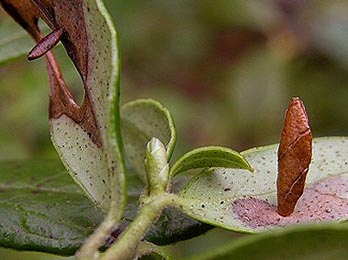|
||||||
|
Coleophora
glitzella Hofmann, 1869 Rannoch Case-bearer Coleophora glitzella Hofmann, 1869. Stett. ent. Ztg. 30: 119. |
|||||||||||||||||||||||||||||||||||||||
Leaf-miner and case-bearer: A complex life cycle with the larvae intially mining the leaves, before forming a small case in the autumn of the year. The final case is 6-8 mm long and the feeding signs are very visible with the larva being able to leave its case and enter the leaf to feed (British leafminers). The larva begins by making a frass-filled corridor of about 1 cm length; then the corridor widens into a blotch. The larva then cuts an elongated piece of epidermis out out the upper and lower epidermis of this blotch and uses it to construct its first case. In first case (elsewhere already in the mine) it passes its first winter. After hibernation it makes a new case in the same way, and later, after another hibernation, a third one. The case of the full-grown larva is a spathulate leaf case of 6-8 mm, composed of two elongates pieces of epidermis. The case is straight; the rear end is somewhat pointed and bivalved. The mouth angle is 90°. The full depth mines that are made by glitzella often occupy half a leaf, and may contain some frass grains. This is because the lava, after having secured its case with silk on the leaf, often leaves the case altogether and may immerse itself deeply in the mine (Bladmineerders van Europa).
Larva: The larvae of moths have a head capsule and chewing mouthparts with opposable mandibles (see video of a gracillarid larva feeding), six thoracic legs and abdominal legs (see examples). Pupa: The pupae of moths have visible head appendages, wings and legs which lie in sheaths (see examples). Adult: The adult is illustrated in UKMoths. The species is included in mothdissection.co.uk. Hosts in Great Britain and Ireland:
Hosts elsewhere:
Time of year - larvae: Two year cycle. Mid-autumn to November, March to May, September to November, March to April (British leafminers). Time of year - adults: Currently unknown. Distribution in Great Britain and Ireland: Britain including East Ross and South Aberdeen (NBN Atlas). Distribution elsewhere: Widespread in continental Europe including Austria, Czech Republic, Danish mainland, Estonia, Finland, Germany, Italian mainland, Latvia, Lithuania, Norwegian mainland, Poland, Romania, Russia - North, Slovakia, Slovenia, Sweden, Switzerland and The Netherlands (Fauna Europaea). NBN Atlas links to known host species:
British and Irish Parasitoids in Britain and elsewhere:
|
|||||||||||||||||||||||||||||||||||||||
|
|
|
| External links: | Search the internet: |
Belgian Lepidoptera |
Find
using Google
Find using Google Scholar Find images using Google |
| Last updated 11-Jul-2019 Brian Pitkin | ||

